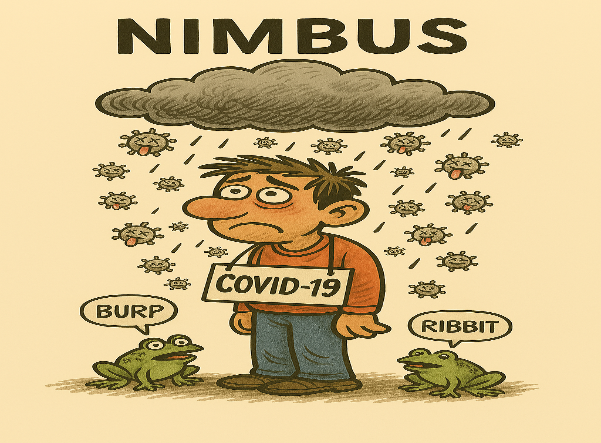Caroline KeeHealth reporter, Source: TODAY
A contagious new COVID-19 variant called NB.1.8.1, aka “Nimbus,” is now dominant in the United States, CDC data show. What to know about symptoms and vaccines.
United States. The mutated omicron subvariant, which causes a painful symptom dubbed “razor blade throat,” now accounts for an estimated 43% of infections in the U.S., data show.
Earlier this year, NB.1.8.1 caused surges in China and other parts of Asia. The variant was first detected in the U.S. in late March through international airport screening programs. Since then, it has been reported in more than half of U.S. states.
On May 23, the World Health Organization classified NB.1.8.1 as a “variant under monitoring” due to its rapid global spread and spike protein mutations, which may affect its transmissibility.
The name “Nimbus” was coined in late May on “X,” by T. Ryan Gregory, a Canadian evolutionary biologist who is behind other popular COVID variant nicknames, including the “FLiRT” strains.
Although NB.1.8.1 is causing a rapidly growing proportion of cases in the U.S., COVID trends remain relatively stable. As of June 21, test positivity is at 3%, 0.1% higher than the previous week, according to the U.S. Centers for Disease Control and Prevention.
The level of COVID viral activity in wastewater is “very low” nationally, per the latest CDC data. However, WastewaterSCAN, which monitors diseases through municipal wastewater systems, reports that national COVID levels are in the “medium” category, a spokesperson tells TODAY.com.
As summer travel peaks, COVID-19 cases are expected to keep rising, experts say. The U.S. has seen COVID-19 cases spike in the summer every year since 2020. The emergence of a mutated new variant, Nimbus, has raised concerns about a possible surge.
Nimbus Now the Dominant Variant in US
During the two-week period ending June 21, NB.1.8.1 accounted for an estimated 43% of cases in the U.S., compared to about 15% in late May, per the latest data from the CDC. In the past weeks, Nimbus overtook the previously dominant LP.8.1 variant.
However, the CDC noted on its website that precision in its reporting is currently “low” due to a lack of sequencing data, which scientists use to track emerging variants.
In its latest update, the CDC did not publish data on the regional spread of NB.1.8.1, but sequences shared with the Global Initiative on Sharing All Influenza Data (GISAID) database show that Nimbus has been detected in at least 28 states so far.
As of July 3, NB.1.8.1 has been reported in the following states, and the District of Columbia:
- Arizona
- Arkansas
- California
- Colorado
- Connecticut
- Florida
- Hawaii
- Illinois
- Maryland
- Massachusetts
- Michigan
- Nebraska
- Nevada
- New Jersey
- New Mexico
- New York
- Ohio
- Oregon
- Pennsylvania
- Rhode Island
- South Dakota
- Texas
- Utah
- Vermont
- Virginia
- Washington
- Wisconsin
- Wyoming
Public health experts predict that cases driven by NB.1.8.1 in the U.S. will likely increase, based on global trends.
Is the New COVID Variant More Transmissible?
The virus that causes COVID, SARS-CoV-2, mutates constantly, giving rise to new variants with genetic changes that may allow the virus to spread more easily or evade existing immunity.
Historically, all descendants of the original Omicron variant have been highly contagious.
NB.1.8.1, derived from the recombinant omicron variant XDV.1.5.1, has several mutations in its spike protein which may affect its transmissibility and ability to escape COVID antibodies from infection or vaccination.
A study published in May, which has not been peer-reviewed, noted that NB.1.8.1’s mutations may allow it to bind better to human cells, which could make it more transmissible and give it the “potential for future dominance” over other variants.
Given its mutations and rapid spread, it’s likely that NB.1.8.1 is more transmissible, but it’s too early to tell how it compares to other strains circulating, experts say.
However, there’s no evidence that Nimbus causes more severe infection severe illness than other variants, and the global risk posed by NB.1.8.1 is considered “low,” the WHO said.
“It’s something we should be keeping an eye on,” Michael Hoerger, Ph.D., associate professor at Tulane University School of Medicine, previously told TODAY.com.
Will Nimbus COVID Cases Keep Rising?
It’s still unclear whether NB.1.8.1 will cause a summer surge stateside, or how severe this wave could be, experts say.
COVID-19 can surge throughout the year, per the CDC. In the U.S., cases tend to peak twice: once in the winter and again during the summer between June and August. The timing and intensity of summer COVID-19 waves in the U.S. can vary.
